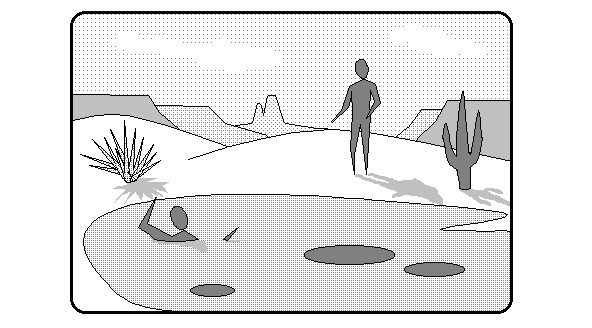by BOB DANIEL, Ph.D.
Long before psychotherapy was invented, healers have been using stories to help their people cope with life’s adversities. More recently, storytellers such as Joseph Campbell, Robert Bly, and Clarissa Pinkola Estes have demonstrated the power of myth for attaining personal transformation. Fannie Flagg dramatized this process in Fried Green Tomatoes at the Whistle Stop Cafe. Here, the elderly Mrs. Threadgoode inspired Evelyn, a dowdy, submissive housewife, by recounting her family tale. Through this encounter, Evelyn was able to discover her own inner strength (Towanda!).
Many such tales have been recorded and preserved as folklore. Countless others, though, are simply passed down orally from generation to generation. Many of these secret treasures risk oblivion in our mass culture, much as medicinal herbs are threatened with extinction from industrial society’s denudation of the tropical rain forests. I wish to share a particular tale from the Daniel family which has proven quite helpful for coping with stress and avoiding the pitfalls of “codependency” in helping others with their problems. So here’s the story of “The Quicksand Beds of Caramba Flats,” as told to me by my Uncle Lester:
The Quicksand Beds of Caramba Flats
“For generations, since long before the Europeans invaded the New World, people have been drawn to the quicksand beds of Caramba Flats. Not that anyone actually wanted to get stuck there, mind you. For miles around, as far as the eye could see, there is only desert, with little life. But here there is water, with its promise of restoration and renewal. Thus, people have sought out these potholes of clear, cool water that pocket the sandy beds. The Native Americans were well aware of the hazards of the quicksand. Yet through their caution and reverence for nature, they could reliably retrieve the water without being sucked under.
“For the Europeans it was quite another matter. Steeped in generations of civilization, they had lost touch with the ways of nature. They had neither the wariness nor the respect that such natural phenomena warrant. After days on the arid plains, they would catch sight of the shimmering water, and it was no mirage. Then they would dash down the nearby dunes and plunge headlong toward the pools. Before they knew it they were chest-deep in quicksand. More often than not, they would panic. And the more they panicked, the quicker the slurry would suck them under. Often, for just long enough to drown before their limp corpses float back up to the surface. From such instances came the lore of quicksand as the great gobbler of life.
“Now, I include these grizzly details because they convey a tragic irony. Namely, we are lighter than this mixture of sand and water. As such, we naturally float in it. Only by struggling and thrashing about do people dig themselves in deeper.
“With so many having lost their lives in these beds, authorities posted wardens to rescue the unsuspecting pioneers. While knowledgeable about quicksand, the first wardens had little understanding of rescue techniques. Legend has it that several early wardens had lost their lives, pulled under by the very victims they were trying to save. Tales provide graphic details of desperate victims clutching at the wardens and climbed up their backs. Thus, they submerged the hapless wardens, drowning them. With no printing presses there at the time, it is now impossible to separate history from myth.
“Whether these tales are actually true, later wardens developed rescue techniques to avoid the desperate clutches of the victims. Rather than venturing into the slurry themselves, they heaved ropes out to the reckless pioneers. Then, they anchored the other end of the rope to a boulder or a stump. This measure allowed the victims to pull themselves out with their own strength.
“Now it would be imprudent to say that the settlers actually tamed Caramba Flats. After all, nothing natural can be truly tamed. Still, they developed a respect for those quicksand beds that allowed them to establish the nearby community of Caramba Flats, right out there in the middle of the arid wasteland.”
The Moral
Now, my Uncle Lester is not the sort who leaves it to your imagination to fill in the moral of a story. So at the end he’d pause and lean over to say, “Now, Bob, I want you to remember this story whenever you feel overwhelmed, up to your neck in muck, so to speak. Just lean back, take a deep breath, and say to yourself, ‘Relax, no reason to worry . It’s only quicksand. I can float in it, and someone will come along to throw me a rope – maybe sooner if I holler.'”
And then he’d cock his finger and add, “Now if you see one of your friends thrashing around in the muck, so to speak, don’t you go jumpin’ in after ’em. Just remember – all you gotta do is throw ’em a rope. They can pull themselves out.”

Bob Daniel, Ph.D. is a retired clinical psychologist who has been practicing in Virginia Beach for over thirty years. He has worked in private practice with adults with mental health and substance abuse issues. While he has been accused of being an unabashed prevaricator, Dr. Daniel insists that his stories are 100% true, even if not factually accurate. Other such true tales include THE ESKIMO WHO LOST HIS ART AND SOUL and THE MAN WITH A MONKEY ON HIS BACK: A STORY OF THE STRUGGLE WITH SELF-BLAME. Still other tales in the “Stories and Fables” category are elaborations of older folk tales.
[whohit]the quicksand beds of caramba flats[/whohit]